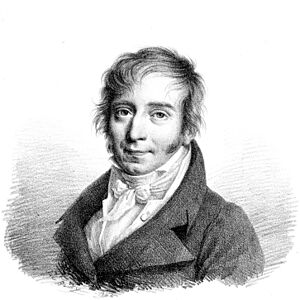Charles-Simon Catel facts for kids
Charles-Simon Catel (born June 10, 1773 – died November 29, 1830) was a very important French composer and teacher. He was born in a town called L'Aigle, in France. Catel is remembered for his music and for helping to teach many young musicians.
Contents
Charles-Simon Catel's Life and Career
Catel began his musical journey at the Royal School of Singing in Paris. He learned a lot about music there. In 1790, he became the main helper to François-Joseph Gossec. Gossec was in charge of the orchestra for the National Guard. This was a big deal!
Catel also became a member of the Institute, a group of important scholars. He helped create military music for special government events. One famous piece was L'Hymne à la Victoire (The Victory Hymn). The words for this hymn were written by Ponce-Denis Écouchard-Lebrun.
He was chosen to be the very first professor of harmony at the famous Conservatoire de Paris. This is a top music school. He taught there for many years, helping students understand how different musical notes fit together. He left his teaching role in 1814.
Many of his students became famous musicians themselves. Some of them won the Prix de Rome, a special award for artists. These students included Joseph Daussoigne-Méhul and Victor Dourlen. Another student was the Belgian composer Martin-Joseph Mengal. He also taught Nicolas-Charles Bochsa, a very well-known harp player. Charles-Simon Catel passed away in Paris.
Catel's Musical Works
Charles-Simon Catel created many different kinds of music. One of his most important works was a book called Treatise on Harmony (published in 1802). This book taught people about music theory. Even the famous composer Hector Berlioz used it when he was young.
Catel also wrote many pieces for concert bands. He composed several dramatic works for the stage. These were performed at big theaters like the Opéra National de Paris and the Théâtre national de l'Opéra-Comique.
Operas and Stage Works
Catel wrote many operas, which are plays set to music. Here are some of his notable stage works:
- Sémiramis (1802): This was a serious opera based on a story by Voltaire. It was performed at the Opéra de Paris.
- Les artistes par occasion (1807): A funny opera performed at the Opéra-Comique.
- L'auberge de Bagnères (1807): Another funny opera, also performed at the Opéra-Comique.
- Les bayadères (1810): An opera performed at the Opéra de Paris, also based on a story by Voltaire.
- Les aubergistes de qualité (1812): A comedy performed at the Opéra-Comique.
- Wallace ou Le ménestrel écossais (1817): An epic opera performed at the Opéra-Comique.
- Zirphile et fleur de myrte ou cent ans en un jour (1818): A magical opera performed at the Opéra de Paris.
Songs and Choral Pieces
Catel also composed music for voices, both solo and for choirs:
- Chant triomphal (1807): A triumphant song.
- Ode sur le Vaisseau Le Vengeur: A special song for a ship called Le Vengeur. It was written for a euphonium (a brass instrument) and an orchestra. The words were by Ponce-Denis Écouchard-Lebrun.
- Hymne sur la reconquête de Toulon: A hymn for a male choir and orchestra.


